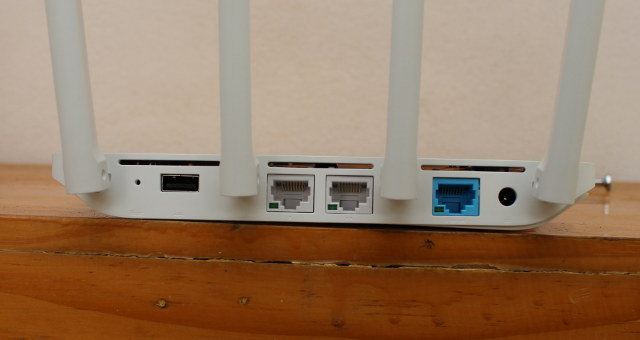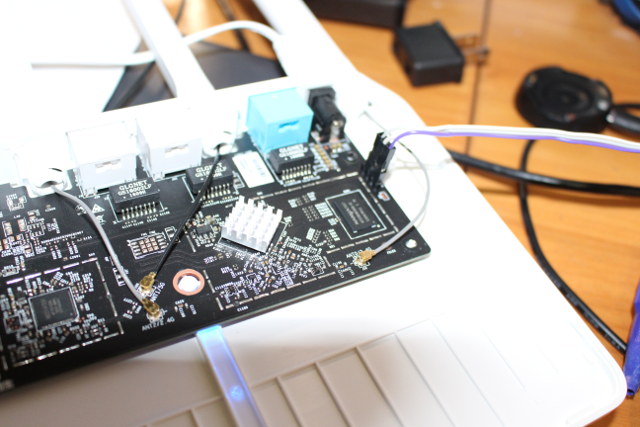Mi WiFi 3 is the new low cost 802.11ac WiFi router by Xiaomi that sells for about $40. GearBest send my one sample for evaluation, and today, I’ve taken some photo of the device and board, and connected the UART pin to see if the serial console was accessible for people who want to try to port OpenWrt for example.
Xiaomi Mi WiFi 3 Unboxing
There’s some information on the package, but everything is in Chinese, except the part about AC1200 meaning it supports up to 867 Mbps with 802.11ac and 300 Mbps using 802.11n.
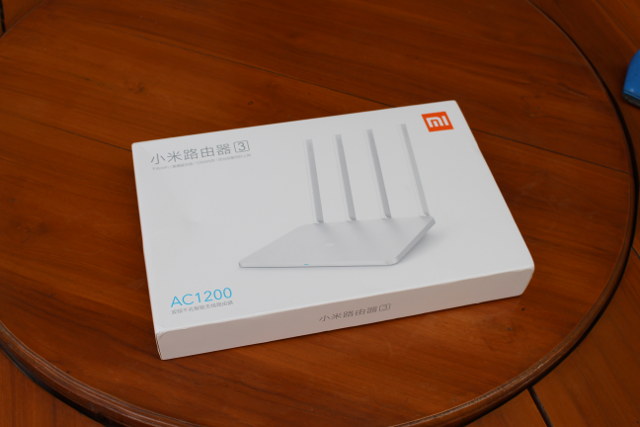 The router comes with a 12V/1A power supply, and a user’s manual in Chinese only. There’s also a QR code inside the box linking to the Android and iOS apps, available both in English and Chinese, so actually that one of the few Xiaomi product that should be easy to use outside of China without some hacks.
The router comes with a 12V/1A power supply, and a user’s manual in Chinese only. There’s also a QR code inside the box linking to the Android and iOS apps, available both in English and Chinese, so actually that one of the few Xiaomi product that should be easy to use outside of China without some hacks.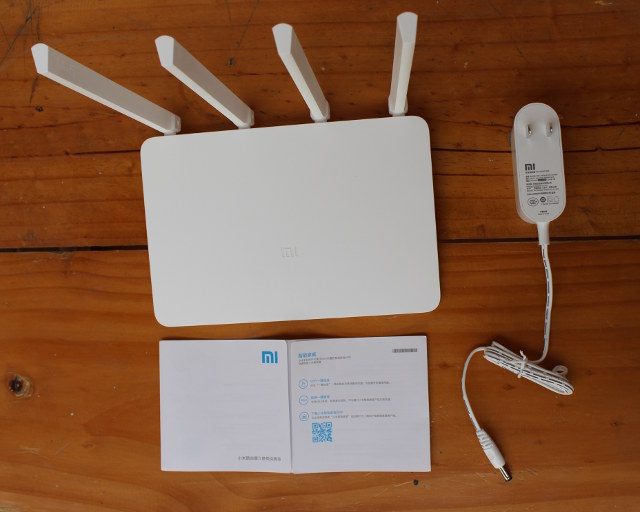
The router has four external antennas.
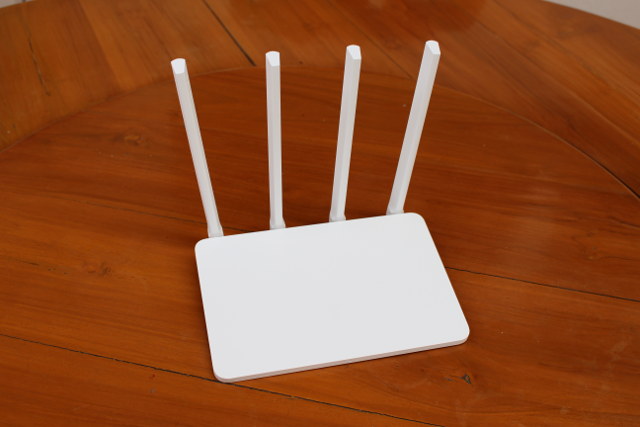 The rear panel features a reset pinhole, a USB port to connect storage, two LAN ports, one WAN port, and the DC jack.
The rear panel features a reset pinhole, a USB port to connect storage, two LAN ports, one WAN port, and the DC jack.
Xiaomi Mi WiFi 3 Router Teardown
First it looks like I only had to pop the bottom of the case with some plastic tool, but then I noticed a screw in the middle was holding it together. So I had to pierce through the sticker with my screwdriver to completely open it.
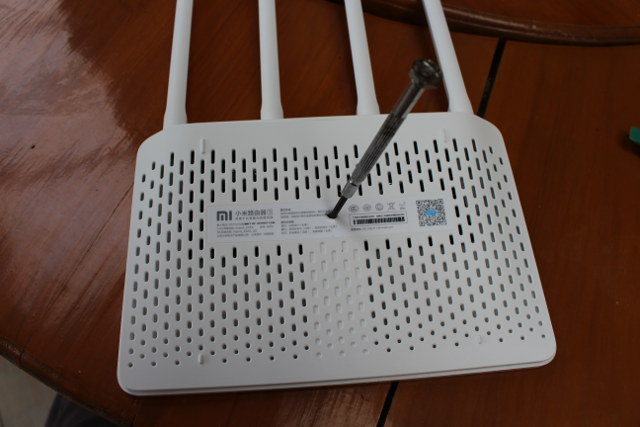 I was a bit surprised that they had used such as large enclosure for a small board,
I was a bit surprised that they had used such as large enclosure for a small board, but maybe marketing is in play here with bigger is better? [Update: Actually, it’s for the router to avoid falling backward due to the weight of the antennas]
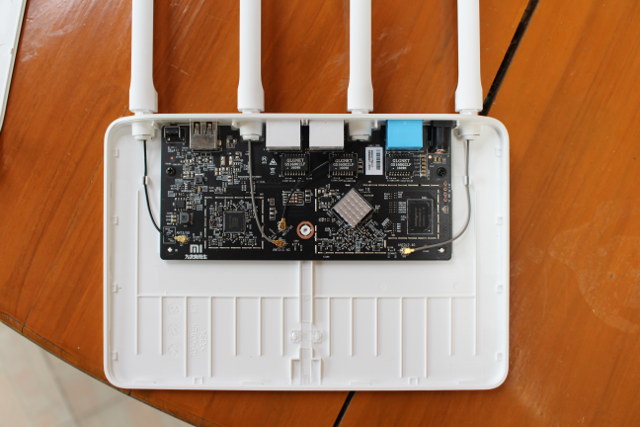
Beside the three GLGNET GSD16002LF 100Mbit magnetics, the main components include Mediatek MT7612EN 802.11a/b/g/n/ac Wi-Fi 2T2R chip, a chip under a small heatsink which must be MT7620A, and NANYA NT5TU64M16HG-AC DDR2 chip (64 MB). You’ll also notice the pin for the serial console are clearly marked on the right side, but more on that below. The two 5GHz antennas are on left, and the two 2.4GHz antennas on the right in the picture above.
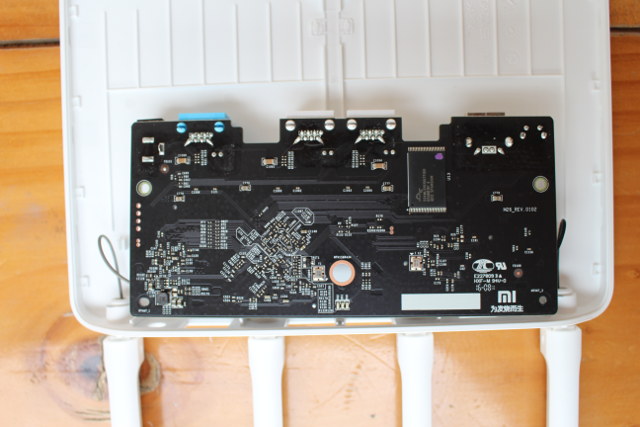
The bottom of the board features Spansion S34ML01G100TF100 flash with 128 MB capacity.
Xiaomi MiWiFi 3 Serial Console
I’ve also soldered a 4-pin header on the right side of the board (GND, Tx, Rx, and 3.3V). to check if I could indeed access the serial console with a USB to TTL debugger adapter.
Then I started minicom with the usual settings (115200 8N1), powered up the board, and I could get the serial log:
Compiled on Jan 1 2014, 17:13:19.
Port /dev/ttyUSB0, 16:21:43Press CTRL-A Z for help on special keys
U-Boot 1.1.3 (Mar 16 2016 – 14:15:12)
Board: Ralink APSoC DRAM: 128 MB
Power on memory test. Memory size= 128 MB…OK!
relocate_code Pointer at: 87fb8000
enable ephy clock…done. rf reg 29 = 5
SSC disabled.
!!! nand page size = 2048, addr len=4
..============================================
Ralink UBoot Version: 4.2.S.1
——————————————–
ASIC 7620_MP (Port5None)
DRAM_CONF_FROM: Auto-detection
DRAM_TYPE: DDR2
DRAM component: 1024 Mbits
DRAM bus: 16 bit
Total memory: 128 MBytes
Flash component: NAND Flash
Date:Mar 16 2016 Time:14:15:12
============================================
icache: sets:512, ways:4, linesz:32 ,total:65536
dcache: sets:256, ways:4, linesz:32 ,total:32768
##### The CPU freq = 580 MHZ ####
estimate memory size =128 Mbytes
Please choose the operation:
1: Load system code to SDRAM via TFTP.
2: Load system code then write to Flash via TFTP.
3: Boot system code via Flash (default).
4: Entr boot command line interface.
9: Load Boot Loader code then write to Flash via TFTP.
3: System Boot system code via Flash.
Booting System 1
..Erasing NAND Flash…
Writing to NAND Flash…
done
## Booting image at bc200000 …
Image Name: MIPS OpenWrt Linux-2.6.36
Image Type: MIPS Linux Kernel Image (lzma compressed)
Data Size: 2616754 Bytes = 2.5 MB
Load Address: 80000000
Entry Point: 80000000
…………………………………. Verifying Checksum … OK
Uncompressing Kernel Image … OK
commandline uart_en=0 factory_mode=0 mem=128m
No initrd
## Transferring control to Linux (at address 80000000) …
## Giving linux memsize in MB, 128
Starting kernel …
LINUX started…
THIS IS ASIC
[ 0.000000] Initializing cgroup subsys cpuset
[ 0.000000] Initializing cgroup subsys cpu
[ 0.000000] Linux version 2.6.36 (jenkins@JenkinsServer) (gcc version 4.6.3 6
[ 0.000000]
[ 0.000000] The CPU feqenuce set to 580 MHz
[ 0.000000] PCIE: bypass PCIe DLL.
[ 0.000000] PCIE: Elastic buffer control: Addr:0x68 -> 0xB4
[ 0.000000] disable all power about PCIe
[ 0.000000] CPU revision is: 00019650 (MIPS 24Kc)
[ 0.000000] Software DMA cache coherency
[ 0.000000] Determined physical RAM map:
[ 0.000000] memory: 08000000 @ 00000000 (usable)
[ 0.000000] User-defined physical RAM map:
[ 0.000000] memory: 08000000 @ 00000000 (usable)
[ 0.000000] Initrd not found or empty – disabling initrd
[ 0.000000] Zone PFN ranges:
[ 0.000000] Normal 0x00000000 -> 0x00008000
[ 0.000000] Movable zone start PFN for each node
[ 0.000000] early_node_map[1] active PFN ranges
[ 0.000000] 0: 0x00000000 -> 0x00008000
[ 0.000000] Built 1 zonelists in Zone order, mobility grouping on. Total pa2
[ 0.000000] Kernel command line: console=ttyS1,115200n8 root=/dev/ram0 uart_m
[ 0.000000] PID hash table entries: 512 (order: -1, 2048 bytes)
[ 0.000000] Dentry cache hash table entries: 16384 (order: 4, 65536 bytes)
[ 0.000000] Inode-cache hash table entries: 8192 (order: 3, 32768 bytes)
[ 0.000000] Primary instruction cache 64kB, VIPT, , 4-waylinesize 32 bytes.
[ 0.000000] Primary data cache 32kB, 4-way, PIPT, no aliases, linesize 32 bys
[ 0.000000] Writing ErrCtl register=0004a6ba
[ 0.000000] Readback ErrCtl register=0004a6ba
[ 0.000000] allocated 655360 bytes of page_cgroup
[ 0.000000] please try ‘cgroup_disable=memory’ option if you don’t want memos
[ 0.000000] Memory: 123440k/131072k available (3347k kernel code, 7632k rese)
[ 0.000000] SLUB: Genslabs=7, HWalign=32, Order=0-3, MinObjects=0, CPUs=1, N1
[ 0.000000] NR_IRQS:128
[ 0.000000] console [ttyS1] enabled
[ 0.010000] Calibrating delay loop… 385.84 BogoMIPS (lpj=1929216)
[ 0.220000] pid_max: default: 32768 minimum: 301
[ 0.220000] Mount-cache hash table entries: 512
[ 0.220000] Initializing cgroup subsys cpuacct
[ 0.230000] Initializing cgroup subsys memory
[ 0.230000] Initializing cgroup subsys net_cls
[ 0.230000] devtmpfs: initialized
[ 0.240000] NET: Registered protocol family 16
[ 0.240000] RALINK_GPIOMODE = 121b1c
[ 0.240000] RALINK_GPIOMODE = 101b1c
[ 0.440000] PPLL_CFG1=0xe44000
[ 0.450000] MT7620 PPLL lock
[ 0.450000] PPLL_DRV =0x80080504
[ 0.650000] Deassert the PCIE0 RESET.
[ 0.650000] start PCIe register access
[ 1.150000] RALINK_RSTCTRL = 2400000
[ 1.160000] RALINK_CLKCFG1 = 75afffc0
[ 1.160000]
[ 1.160000] *************** MT7620 PCIe RC mode *************
[ 1.660000] PCIE0 enabled
[ 1.670000] init_rt2880pci done
[ 1.670000] bio: create slab at 0
[ 1.680000] SCSI subsystem initialized
[ 1.680000] usbcore: registered new interface driver usbfs
[ 1.680000] usbcore: registered new interface driver hub
[ 1.690000] usbcore: registered new device driver usb
[ 1.690000] pci 0000:00:00.0: BAR 0: can’t assign mem (size 0x80000000)
[ 1.700000] pci 0000:00:00.0: BAR 8: assigned [mem 0x20000000-0x200fffff]
[ 1.700000] pci 0000:00:00.0: BAR 9: assigned [mem 0x20100000-0x201fffff pre]
[ 1.710000] pci 0000:00:00.0: BAR 1: assigned [mem 0x20200000-0x2020ffff]
[ 1.710000] pci 0000:00:00.0: BAR 1: set to [mem 0x20200000-0x2020ffff] (PCI]
[ 1.720000] pci 0000:01:00.0: BAR 0: assigned [mem 0x20000000-0x200fffff 64b]
[ 1.720000] pci 0000:01:00.0: BAR 0: set to [mem 0x20000000-0x200fffff 64bit]
[ 1.730000] pci 0000:01:00.0: BAR 6: assigned [mem 0x20100000-0x2010ffff pre]
[ 1.730000] pci 0000:00:00.0: PCI bridge to [bus 01-01]
[ 1.740000] pci 0000:00:00.0: bridge window [io disabled]
[ 1.740000] pci 0000:00:00.0: bridge window [mem 0x20000000-0x200fffff]
[ 1.750000] pci 0000:00:00.0: bridge window [mem 0x20100000-0x201fffff pre]
[ 1.750000] BAR0 at slot 0 = 0
[ 1.760000] bus=0x0, slot = 0x0
[ 1.760000] res[0]->start = 0
[ 1.760000] res[0]->end = 0
[ 1.760000] res[1]->start = 20200000
[ 1.770000] res[1]->end = 2020ffff
[ 1.770000] res[2]->start = 0
[ 1.770000] res[2]->end = 0
[ 1.770000] res[3]->start = 0
[ 1.780000] res[3]->end = 0
[ 1.780000] res[4]->start = 0
[ 1.780000] res[4]->end = 0
[ 1.780000] res[5]->start = 0
[ 1.790000] res[5]->end = 0
[ 1.790000] bus=0x1, slot = 0x0
[ 1.790000] res[0]->start = 20000000
[ 1.790000] res[0]->end = 200fffff
[ 1.800000] res[1]->start = 0
[ 1.800000] res[1]->end = 0
[ 1.800000] res[2]->start = 0
[ 1.800000] res[2]->end = 0
[ 1.810000] res[3]->start = 0
[ 1.810000] res[3]->end = 0
[ 1.810000] res[4]->start = 0
[ 1.810000] res[4]->end = 0
[ 1.820000] res[5]->start = 0
[ 1.820000] res[5]->end = 0
[ 1.820000] Switching to clocksource MIPS
[ 1.830000] NET: Registered protocol family 2
[ 1.830000] IP route cache hash table entries: 1024 (order: 0, 4096 bytes)
[ 1.840000] TCP established hash table entries: 4096 (order: 3, 32768 bytes)
[ 1.850000] TCP bind hash table entries: 4096 (order: 2, 16384 bytes)
[ 1.850000] TCP: Hash tables configured (established 4096 bind 4096)
[ 1.860000] TCP reno registered
[ 1.860000] UDP hash table entries: 256 (order: 0, 4096 bytes)
[ 1.870000] UDP-Lite hash table entries: 256 (order: 0, 4096 bytes)
[ 1.870000] NET: Registered protocol family 1
[ 3.280000] RT3xxx EHCI/OHCI init.
[ 3.290000] msgmni has been set to 241
[ 3.290000] Block layer SCSI generic (bsg) driver version 0.4 loaded (major )
[ 3.300000] io scheduler noop registered (default)
[ 3.310000] RALINK_REG_PIO7140DATA b0000670 = 0
[ 3.410000] RALINK_REG_PIO7140DATA b0000670 = 2000000
[ 3.420000] Ralink gpio driver initialized
[ 3.420000] Serial: 8250/16550 driver, 2 ports, IRQ sharing disabled
[ 3.430000] serial8250: ttyS0 at MMIO 0x10000500 (irq = 37) is a 16550A
[ 3.430000] serial8250: ttyS1 at MMIO 0x10000c00 (irq = 12) is a 16550A
[ 3.440000] init reset module!
[ 3.450000] brd: module loaded
[ 3.450000] !!! nand page size = 2048, addr len=4
[ 3.460000] ra_nand_init: alloc 1350, at 87d90000 , btt(87d910c0, 100), ranf0
[ 3.470000] Creating 13 MTD partitions on “ra_nfc”:
[ 3.470000] 0x000000000000-0x000008000000 : “ALL”
[ 3.500000] 0x000000000000-0x000000040000 : “Bootloader”
[ 3.510000] 0x000000040000-0x000000080000 : “Config”
[ 3.510000] 0x000000080000-0x0000000c0000 : “Bdata”
[ 3.520000] 0x0000000c0000-0x000000100000 : “Factory”
[ 3.530000] 0x000000100000-0x000000140000 : “crash”
[ 3.530000] 0x000000140000-0x000000180000 : “crash_syslog”
[ 3.540000] 0x000000180000-0x000000200000 : “reserved0”
[ 3.540000] 0x000000200000-0x000000600000 : “kernel0”
[ 3.550000] 0x000000600000-0x000000a00000 : “kernel1”
[ 3.560000] 0x000000a00000-0x000002a00000 : “rootfs0”
[ 3.560000] 0x000002a00000-0x000004a00000 : “rootfs1”
[ 3.570000] 0x000004a00000-0x000008000000 : “overlay”
[ 3.570000] rdm_major = 253
[ 3.580000] SMACCR1 — : 0x0000f0b4
[ 3.580000] SMACCR0 — : 0x2985a41d
[ 3.580000] Ralink APSoC Ethernet Driver Initilization. v3.0 256 rx/tx desc!
[ 3.590000] SMACCR1 — : 0x0000f0b4
[ 3.600000] SMACCR0 — : 0x2985a41d
[ 3.600000] PROC INIT OK!
[ 3.610000] PPP generic driver version 2.4.2
[ 3.610000] PPP MPPE Compression module registered
[ 3.620000] NET: Registered protocol family 24
[ 3.620000] PPTP driver version 0.8.5
[ 3.630000] ehci_hcd: USB 2.0 ‘Enhanced’ Host Controller (EHCI) Driver
[ 3.750000] rt3xxx-ehci rt3xxx-ehci: Ralink EHCI Host Controller
[ 3.760000] rt3xxx-ehci rt3xxx-ehci: new USB bus registered, assigned bus nu1
[ 3.800000] rt3xxx-ehci rt3xxx-ehci: irq 18, io mem 0x101c0000
[ 3.820000] rt3xxx-ehci rt3xxx-ehci: USB 0.0 started, EHCI 1.00
[ 3.820000] hub 1-0:1.0: USB hub found
[ 3.830000] hub 1-0:1.0: 1 port detected
[ 3.830000] ohci_hcd: USB 1.1 ‘Open’ Host Controller (OHCI) Driver
[ 3.860000] rt3xxx-ohci rt3xxx-ohci: RT3xxx OHCI Controller
[ 3.860000] rt3xxx-ohci rt3xxx-ohci: new USB bus registered, assigned bus nu2
[ 3.870000] rt3xxx-ohci rt3xxx-ohci: irq 18, io mem 0x101c1000
[ 3.940000] hub 2-0:1.0: USB hub found
[ 3.940000] hub 2-0:1.0: 1 port detected
[ 3.950000] usbcore: registered new interface driver cdc_acm
[ 3.950000] cdc_acm: v0.26:USB Abstract Control Model driver for USB modems s
[ 3.960000] Initializing USB Mass Storage driver…
[ 3.970000] usbcore: registered new interface driver usb-storage
[ 3.970000] USB Mass Storage support registered.
[ 3.980000] usbcore: registered new interface driver usbserial
[ 3.980000] USB Serial support registered for generic
[ 3.990000] usbcore: registered new interface driver usbserial_generic
[ 4.000000] usbserial: USB Serial Driver core
[ 4.000000] USB Serial support registered for pl2303
[ 4.010000] usbcore: registered new interface driver pl2303
[ 4.010000] pl2303: Prolific PL2303 USB to serial adaptor driver
[ 4.020000] USB Serial support registered for TI USB 3410 1 port adapter
[ 4.030000] USB Serial support registered for TI USB 5052 2 port adapter
[ 4.030000] usbcore: registered new interface driver ti_usb_3410_5052
[ 4.040000] ti_usb_3410_5052: v0.10:TI USB 3410/5052 Serial Driver
[ 4.050000] Software Watchdog Timer: 0.07 initialized. soft_noboot=0 soft_ma)
[ 4.050000] u32 classifier
[ 4.060000] input device check on
[ 4.060000] Actions configured
[ 4.060000] Netfilter messages via NETLINK v0.30 with ipset netlink.patch.
[ 4.070000] nf_conntrack version 0.5.0 (1928 buckets, 7712 max)
[ 4.080000] xt_time: kernel timezone is -0000
[ 4.080000] GRE over IPv4 demultiplexor driver
[ 4.090000] ip_tables: (C) 2000-2006 Netfilter Core Team, Type=Restricted Coe
[ 4.100000] TCP cubic registered
[ 4.100000] NET: Registered protocol family 10
[ 4.110000] NET: Registered protocol family 17
[ 4.110000] L2TP core driver, V2.0
[ 4.110000] PPPoL2TP kernel driver, V2.0
[ 4.120000] L2TP netlink interface
[ 4.120000] 802.1Q VLAN Support v1.8 Ben Greear <greearb@candelatech.com>
[ 4.130000] All bugs added by David S. Miller <davem@redhat.com>
[ 4.150000] Freeing unused kernel memory: 1188k freed
[ 4.240000] Loading essential drivers…
[ 4.250000] Press Ctrl+C to enter RAMFS…
[ 5.260000] Check for USB recovery…
[ 5.290000] Bringup the system…
[ 5.300000] flag_boot_rootfs=0 mounting /dev/mtd10
[ 5.310000] UBI: attaching mtd10 to ubi0
[ 5.310000] UBI: physical eraseblock size: 131072 bytes (128 KiB)
[ 5.320000] UBI: logical eraseblock size: 126976 bytes
[ 5.320000] UBI: smallest flash I/O unit: 2048
[ 5.330000] UBI: VID header offset: 2048 (aligned 2048)
[ 5.340000] UBI: data offset: 4096
[ 5.490000] UBI: max. sequence number: 2
[ 5.500000] UBI: attached mtd10 to ubi0
[ 5.500000] UBI: MTD device name: “rootfs0”
[ 5.510000] UBI: MTD device size: 32 MiB
[ 5.510000] UBI: number of good PEBs: 256
[ 5.520000] UBI: number of bad PEBs: 0
[ 5.520000] UBI: max. allowed volumes: 128
[ 5.530000] UBI: wear-leveling threshold: 4096
[ 5.530000] UBI: number of internal volumes: 1
[ 5.540000] UBI: number of user volumes: 1
[ 5.540000] UBI: available PEBs: 0
[ 5.550000] UBI: total number of reserved PEBs: 256
[ 5.550000] UBI: number of PEBs reserved for bad PEB handling: 4
[ 5.560000] UBI: max/mean erase counter: 1/0
[ 5.560000] UBI: image sequence number: 1026081047
[ 5.570000] UBI: background thread “ubi_bgt0d” started, PID 80
UBI device number 0, total 256 LEBs (32505856 bytes, 31.0 MiB), available 0 LEB)
[ 5.660000] UBIFS: mounted UBI device 0, volume 0, name “system”
[ 5.660000] UBIFS: mounted read-only
[ 5.670000] UBIFS: file system size: 30093312 bytes (29388 KiB, 28 MiB, 23)
[ 5.670000] UBIFS: journal size: 9023488 bytes (8812 KiB, 8 MiB, 72 LE)
[ 5.680000] UBIFS: media format: w4/r0 (latest is w4/r0)
[ 5.690000] UBIFS: default compressor: zlib
[ 5.690000] UBIFS: reserved for root: 0 bytes (0 KiB)
config core ‘version’
# ROM ver
option ROM ‘2.8.12’
# channel
option CHANNEL ‘release’
# hardware platform R1AC or R1N etc.
option HARDWARE ‘R3’
# CFE ver
option UBOOT ‘1.0.2’
# Linux Kernel ver
option LINUX ‘0.1.12’
# RAMFS ver
option RAMFS ‘0.1.12’
# SQUASHFS ver
option SQAFS ‘0.1.12’
# ROOTFS ver
option ROOTFS ‘0.1.12’
#build time
option BUILDTIME ‘Wed, 16 Mar 2016 14:13:36 +0800’
#build timestamp
option BUILDTS ‘1458108816’
#build git tag
option GTAG ‘commit 17f50389a144da43f3858d508d9de41885282406’
mount: mounting proc on /proc failed: Device or resource busy
mount: mounting sysfs on /sys failed: Device or resource busy
[ 6.460000] Raeth v3.0 (Tasklet,SkbRecycle)
[ 6.460000]
[ 6.460000] phy_tx_ring = 0x074c7000, tx_ring = 0xa74c7000
[ 6.460000]
[ 6.460000] phy_rx_ring0 = 0x07df0000, rx_ring0 = 0xa7df0000
[ 6.460000] SMACCR1 — : 0x0000f0b4
[ 6.460000] SMACCR0 — : 0x2985a41d
[ 6.490000] CDMA_CSG_CFG = 81000000
[ 6.490000] GDMA1_FWD_CFG = 20710000
– preinit –
Wed Mar 16 14:27:38 UTC 2016
– regular preinit –
[ 6.670000] UBI: attaching mtd12 to ubi1
[ 6.670000] UBI: physical eraseblock size: 131072 bytes (128 KiB)
[ 6.680000] UBI: logical eraseblock size: 126976 bytes
[ 6.680000] UBI: smallest flash I/O unit: 2048
[ 6.690000] UBI: VID header offset: 2048 (aligned 2048)
[ 6.690000] UBI: data offset: 4096
[ 6.940000] UBI: max. sequence number: 122
[ 6.960000] UBI: attached mtd12 to ubi1
[ 6.960000] UBI: MTD device name: “overlay”
[ 6.970000] UBI: MTD device size: 54 MiB
[ 6.970000] UBI: number of good PEBs: 432
[ 6.980000] UBI: number of bad PEBs: 0
[ 6.980000] UBI: max. allowed volumes: 128
[ 6.990000] UBI: wear-leveling threshold: 4096
[ 6.990000] UBI: number of internal volumes: 1
[ 7.000000] UBI: number of user volumes: 1
[ 7.000000] UBI: available PEBs: 0
[ 7.000000] UBI: total number of reserved PEBs: 432
[ 7.010000] UBI: number of PEBs reserved for bad PEB handling: 8
[ 7.020000] UBI: max/mean erase counter: 1/0
[ 7.020000] UBI: image sequence number: 35629411
[ 7.030000] UBI: background thread “ubi_bgt1d” started, PID 149
UBI device number 1, total 432 LEBs (54853632 bytes, 52.3 MiB), available 0 LEB)
[ 7.080000] UBIFS: recovery needed
[ 7.130000] UBIFS: recovery completed
[ 7.130000] UBIFS: mounted UBI device 1, volume 0, name “data”
[ 7.140000] UBIFS: file system size: 52187136 bytes (50964 KiB, 49 MiB, 41)
[ 7.140000] UBIFS: journal size: 2666496 bytes (2604 KiB, 2 MiB, 21 LE)
[ 7.150000] UBIFS: media format: w4/r0 (latest is w4/r0)
[ 7.160000] UBIFS: default compressor: lzo
[ 7.160000] UBIFS: reserved for root: 2464926 bytes (2407 KiB)
/lib/preinit.sh: line 1: jffs2_not_mounted: not found
– init –
[ 7.760000] ra2880stop()…Done
[ 7.780000] Free TX/RX Ring Memory!
init started: BusyBox v1.19.4 (2016-03-16 14:06:55 CST)
Please press Enter to activate this console. rcS S boot: INFO: rc script run ti.
[ 8.800000] tntfs: module license ‘Commercial. For support email ntfs-suppor.
[ 8.810000] Disabling lock debugging due to kernel taint
[ 8.850000] Tuxera NTFS driver 3015.1.29 [Flags: R/W MODULE].
[ 8.950000] Tuxera FAT 12/16/32 driver version 3014.1.24 [Flags: R/W MODULE].
[ 9.010000] tun: Universal TUN/TAP device driver, 1.6
[ 9.020000] tun: (C) 1999-2004 Max Krasnyansky <maxk@qualcomm.com>
[ 9.040000] Mirror/redirect action on
[ 9.300000] GRE over IPv4 tunneling driver
[ 9.530000] ipt: xt_cgroup_MARK installed ok.
[ 9.600000] ip_set: protocol 6
[ 9.880000] sstack_init
[ 11.170000] [ 11.180000] [ 12.720000] [ 12.740000] CSRBaseAddress =0xc1100000, csr_addr=0xc1100000!
[ 12.750000] MAC_CSR0=1986146304, RtmpChipOpsHook
[ 12.760000] dev idx = 1!
[ 12.760000] get_dev_config_idx pAd->MACVersion = 76623000, pAd->ChipID4
Wed Mar 16 22:27:44 CST 2016 netconfig[405]: INFO: loading exist /etc/config/ne.
Wed Mar 16 22:27:44 CST 2016 netconfig[405]: #### Loopback configuration
Wed Mar 16 22:27:44 CST 2016 netconfig[405]: config interface loopback
Wed Mar 16 22:27:44 CST 2016 netconfig[405]: option ifname lo
Wed Mar 16 22:27:44 CST 2016 netconfig[405]: option proto static
Wed Mar 16 22:27:44 CST 2016 netconfig[405]: option ipaddr 127.0.0.1
Wed Mar 16 22:27:44 CST 2016 netconfig[405]: option netmask 255.0.0.0
Wed Mar 16 22:27:44 CST 2016 netconfig[405]: #### LAN configuration
Wed Mar 16 22:27:44 CST 2016 netconfig[405]: config interface lan
Wed Mar 16 22:27:44 CST 2016 netconfig[405]: option ifname eth0.1
Wed Mar 16 22:27:44 CST 2016 netconfig[405]: option type bridge
Wed Mar 16 22:27:44 CST 2016 netconfig[405]: option proto static
Wed Mar 16 22:27:44 CST 2016 netconfig[405]: option ipaddr 192.168.31.1
Wed Mar 16 22:27:44 CST 2016 netconfig[405]: option netmask 255.255.255.0
Wed Mar 16 22:27:44 CST 2016 netconfig[405]: #### WAN configuration
Wed Mar 16 22:27:44 CST 2016 netconfig[405]: config interface wan
Wed Mar 16 22:27:44 CST 2016 netconfig[405]: option ifname eth0.2
Wed Mar 16 22:27:44 CST 2016 netconfig[405]: option proto dhcp
Wed Mar 16 22:27:44 CST 2016 netconfig[405]: ### IFB interface for MiQoS
Wed Mar 16 22:27:44 CST 2016 netconfig[405]: config interface ifb
Wed Mar 16 22:27:44 CST 2016 netconfig[405]: option ifname ifb0
Wed Mar 16 22:27:44 CST 2016 netconfig[405]: #### READY configuration
Wed Mar 16 22:27:44 CST 2016 netconfig[405]: config interface ready
Wed Mar 16 22:27:44 CST 2016 netconfig[405]: option proto static
Wed Mar 16 22:27:45 CST 2016 netconfig[405]: option ipaddr 169.254.29.1
Wed Mar 16 22:27:45 CST 2016 netconfig[405]: option netmask 255.255.255.0
[ 15.230000] Raeth v3.0 (Tasklet,SkbRecycle)
[ 15.230000]
[ 15.230000] phy_tx_ring = 0x05e6f000, tx_ring = 0xa5e6f000
[ 15.230000]
[ 15.230000] phy_rx_ring0 = 0x05e5d000, rx_ring0 = 0xa5e5d000
[ 15.230000] SMACCR1 — : 0x0000f0b4
[ 15.230000] SMACCR0 — : 0x2985a41d
[ 15.250000] CDMA_CSG_CFG = 81000000
[ 15.260000] GDMA1_FWD_CFG = 20710000
[ 15.280000] device eth0.1 entered promiscuous mode
[ 15.290000] device eth0 entered promiscuous mode
[ 15.310000] br-lan: port 1(eth0.1) entering learning state
[ 15.310000] br-lan: port 1(eth0.1) entering learning state
[ 16.020000] MAC_CSR0=1986146304, rtmp_asic_top_init
[ 16.150000] Set_Bsd_Proc 7114 Bsd 0
[ 17.310000] br-lan: port 1(eth0.1) entering forwarding state
[ 19.370000] <==== rt28xx_init, Status=0
[ 21.640000] device wl0 entered promiscuous mode
[ 21.640000] br-lan: port 2(wl0) entering learning state
[ 21.650000] br-lan: port 2(wl0) entering learning state
[ 22.250000] Set_Bsd_Proc 6786 Bsd 0
[ 23.650000] br-lan: port 2(wl0) entering forwarding state
For some reasons, I could not access the command line, as Rx did not seem to work. Not exactly sure why yet.
As mentioned in the introduction, GearBest sent the review sample, and you could purchase the router for $34.99 shipped from their website. The router is also sold for less than $40 on Aliexpress, GeekBuying, and probably other e-retailers.

Jean-Luc started CNX Software in 2010 as a part-time endeavor, before quitting his job as a software engineering manager, and starting to write daily news, and reviews full time later in 2011.
Support CNX Software! Donate via cryptocurrencies, become a Patron on Patreon, or purchase goods on Amazon or Aliexpress


